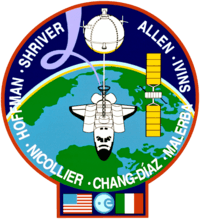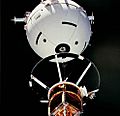STS-46 facts for kids

Atlantis's Canadarm grapples the European Space Agency's EURECA satellite, prior to its deployment.
|
|
| Names | Space Transportation System-49 |
|---|---|
| Mission type | EURECA satellite deployment Technology |
| Operator | NASA |
| Mission duration | 7 days, 23 hours, 15 minutes, 3 seconds (achieved) |
| Distance travelled | 5,344,643 km (3,321,007 mi) |
| Orbits completed | 127 |
| Spacecraft properties | |
| Spacecraft | Space Shuttle Atlantis |
| Launch mass | 116,134 kg (256,032 lb) |
| Landing mass | 94,676 kg (208,725 lb) |
| Payload mass | 12,164 kg (26,817 lb) |
| Crew | |
| Crew size | 7 |
| Members |
|
| Start of mission | |
| Launch date | July 31, 1992, 13:56:48 UTC |
| Rocket | Space Shuttle Atlantis |
| Launch site | Kennedy Space Center, LC-39B |
| Contractor | Rockwell International |
| End of mission | |
| Landing date | August 8, 1992, 13:11:50 UTC |
| Landing site | Kennedy Space Center, SLF Runway 33 |
| Orbital parameters | |
| Reference system | Geocentric orbit |
| Regime | Low Earth orbit |
| Perigee | 425 km (264 mi) |
| Apogee | 437 km (272 mi) |
| Inclination | 28.46° |
| Period | 93.20 minutes |
 STS-46 mission patch  Standing: Ivins, Nicollier, Hoffman, Chang-Díaz, Malerba Seated: Allen, Shriver |
|
STS-46 was a NASA Space Shuttle mission that used the orbiter Atlantis. It launched on July 31, 1992, and returned to Earth on August 8, 1992. This mission lasted for nearly eight days.
The main goals of STS-46 were to put two important satellites into orbit. One was the European Retrievable Carrier (EURECA) from the European Space Agency. The other was the Tethered Satellite System (TSS-1), a joint project between NASA and the Italian Space Agency.
Contents
Meet the STS-46 Crew
The STS-46 mission had a team of seven astronauts. They worked together to complete the mission's goals in space.
| Position | Astronaut | |
|---|---|---|
| Commander | Third and last spaceflight |
|
| Pilot | First spaceflight |
|
| Mission Specialist 1 | First spaceflight |
|
| Mission Specialist 2 | Second spaceflight |
|
| Mission Specialist 3 | Third spaceflight |
|
| Mission Specialist 4 | Third spaceflight |
|
| Payload Specialist 1 | Only spaceflight |
|
Mission Goals and Highlights
The STS-46 mission had two main objectives: deploying the EURECA satellite and the TSS-1 satellite. Both deployments faced some challenges.
Deploying the EURECA Satellite
The European Retrievable Carrier (EURECA) is a science satellite. It was designed to carry different experiments into space. The plan was to deploy EURECA on the second day of the mission.
However, there was a small problem with EURECA's data system. This caused a delay of one day. After EURECA was released, its engines were supposed to push it higher into its working orbit. This boost was cut short because the satellite sent unexpected information about its position.
The team on Earth worked to fix the problem. On the sixth day of the mission, EURECA successfully reached its correct orbit. It stayed in space for about a year before being retrieved by another Space Shuttle mission.
The Tethered Satellite System (TSS-1)
The Tethered Satellite System (TSS-1) was another important part of the mission. This satellite was meant to be lowered from the Space Shuttle on a long, thin cable, like a kite on a string. The goal was to extend the tether to 20 kilometers (about 12 miles) away from the shuttle.
The TSS-1 deployment was also delayed because of the issues with EURECA. When it was finally deployed, the satellite only reached about 260 meters (about 850 feet) from Atlantis. The tether line got stuck and would not extend further.
The astronauts tried for several days to free the tether. Unfortunately, they could not fix the problem. The TSS-1 satellite was then pulled back into the shuttle's cargo bay. It was returned to Earth to be studied and fixed.
TSS-1's Second Chance
Even though TSS-1 didn't work as planned on STS-46, it got a second chance. It flew again in 1996 on the STS-75 mission. Interestingly, some of the same astronauts from STS-46, including Andrew Allen, Jeffrey Hoffman, Claude Nicollier, and Franklin Chang-Díaz, also flew on STS-75.
Other Experiments on Board
Besides the two main satellites, STS-46 carried several other scientific experiments. These included:
- Experiments to study how materials behave in space, especially with oxygen.
- Tests for new materials in the space environment.
- A special IMAX camera in the cargo bay to film the mission.
- Studies on how space affects human cells, like those that produce growth hormone.
- Instruments to observe plumes (like exhaust from engines) in ultraviolet light.
The mission was even extended by one day to make sure all these scientific goals could be completed.
Images for kids






